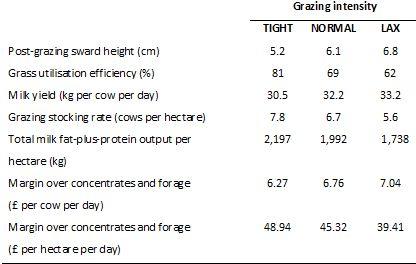AFBI research targets improved management strategies for grazing dairy cows
Date published:
If efficiently utilised, grazed grass remains the lowest-cost feed for dairy cows within Northern Ireland, and its use has the potential to provide local farmers with a key competitive advantage over many of our global competitors. However, the milk-yield potential of most dairy cows in Northern Ireland has increased considerably during the last few decades, and consequently grazed grass as the sole feed is frequently unable to meet the energy requirements of higher-yielding cows during the grazing season. Concentrate feeding has an important role in addressing this “energy gap”.

Nevertheless, concentrates are expensive, and therefore it is important that an economic milk-yield response is achieved when concentrates are offered. In addition, spread calving patterns on most farms result in wide ranges of milk yields within herds, meaning that identifying economically optimum concentrate feeding strategies can be a challenge.
To address this issue, DARD and AgriSearch commissioned the Agri-Food and Biosciences Institute (AFBI) at Hillsborough to undertake four studies to examine a number of management strategies for grazing dairy cows. Full results from these studies will be available from AgriSearch shortly in the form of a farmers’ booklet. A brief summary of the research outlined in the booklet is provided within this article.
Research undertaken
Study 1: Identifying optimum concentrate feeding rates: Concentrate feed levels for grazing cows are often determined by assuming that grazed grass will provide the cow with the energy required for ‘maintenance’, plus a certain level of milk production (the ‘Maintenance-Plus’ or ‘M+’ value), with concentrates then offered at a specific feeding rate to support milk yields above the Maintenance-Plus value. A feeding rate of 0.45kg of concentrate per litre of milk produced above Maintenance-Plus is commonly used in practice. This study examined the impact on cow performance of adopting concentrate feeding rates greater than and less than this value. Three feeding rates (0.25, 0.45, and 0.65kg of concentrate per litre of milk above Maintenance-Plus) were examined within a ‘feed-to-yield’ system.

Study 2: Identifying optimum Maintenance-Plus values: Estimating appropriate Maintenance-Plus values to be adopted for dairy cows offered grazed grass supplemented with concentrate can be problematic. This study examined the effect of adopting three levels of Maintenance-Plus (‘High’, ‘Medium’, or ‘Low’) values on concentrate requirements and cow performance. These levels of Maintenance-Plus values (for cows in second or subsequent lactations) are presented in Figure 1, with values adopted for first-lactation heifers being 20% lower. Concentrates were offered at a rate of 0.45 kg per litre of milk produced above the Maintenance-Plus values.


Average daily concentrate intakes were the same for both groups, despite the different feeding strategies (4.0 kg per cow per day for both). However, individual cows within the feed-to-yield strategy were offered a broader range of concentrate levels (1.0 to 10.0 kg per cow per day). Concentrate feeding strategy had no effect on milk yield, milk quality, or on cow live weight or body condition score at the end of the study (Table 3). In summary, concentrate allocation strategy had little impact on the performance of mid-lactation cows producing moderate milk yields.

As grazing intensity increased, post-grazing sward height decreased (Table 4). However, grass utilisation efficiency and grazing stocking rate increased. Moving from a NORMAL (i.e. a post grazing sward height of 6.1 cm) to a LAX (6.8cm) grazing intensity had no significant effect on cow performance, but resulted in a reduction in grass utilisation efficiency and milk output per hectare. With high levels of concentrate feeding, milk yield per cow was reduced with ‘TIGHT’ grazing (5.2cm). However, milk output per ha and margin per ha were greatest with TIGHT grazing. When land availability is limiting, this approach may be optimal, and under good grazing conditions can be achieved without a loss of cow body condition.
Conclusion
The results of this AFBI research programme will aid farmers in Northern Ireland to efficiently utilise grazed grass in dairy cow diets. It also provides information on the supplementation of dairy cows with concentrate feed during the grazing season. Full details of each of these studies will be published shortly in a farmers’ booklet, which will be available to download from the AgriSearch website (www.agrisearch.org), with hard copies available on request.
by Andrew Dale and Peter Purcell, Agri-Food and Biosciences Institute, Hillsborough
Notes to editors:
AFBI carries out high quality technology research and development, statutory, analytical, and diagnostic testing functions for DARD and other Government departments, public bodies and commercial companies. AFBI's Vision is “Scientific excellence in Northern Ireland … serving the world”.All media enquiries to AFBI Press Office.